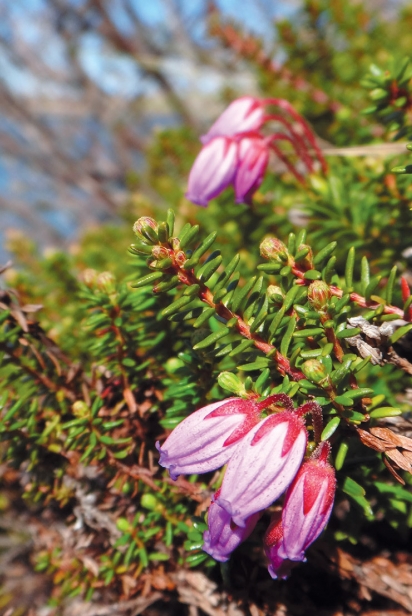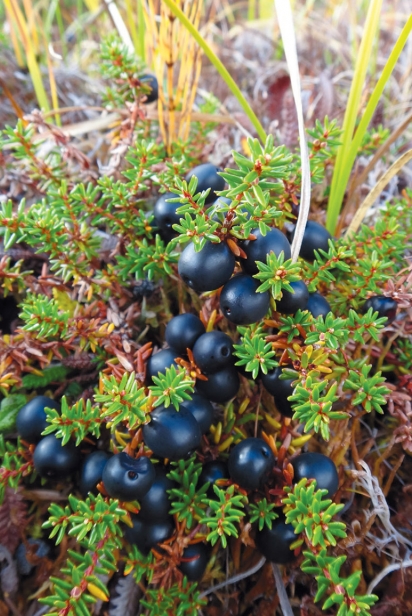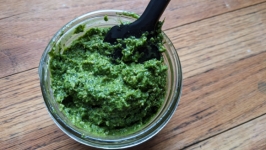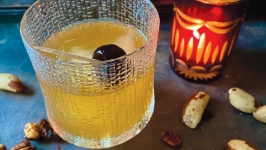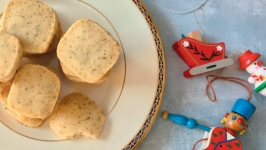Beauty in the Backcountry
Crowberry, Empetrum nigrum
The first time I spotted these gleaming berries in the rolling alpine of Denali National Park, I thought they were the most exotic and beautiful berries I had ever seen. After tasting their subtle, sweet flavor, they instantly became one of my favorites.
Since then, I have regularly encountered crowberries all over the state, around the villages of the Lower Yukon River to the tundra bluffs of the Northwest Arctic, in the Arctic alpine of the Brooks Range, next to glaciers of Wrangell-St Elias national park, and in the bogs of Southeast Alaska. One spring, I found pretty pink bells flowering by the Bering Sea. For the longest time, I thought these were crowberry flowers, but I recently learned that this plant is called Phyllodoce caerulea, sometimes known as purple mountain heather or blue heath. While this plant is in the same family as crowberry (Ericacea, or heather family), crowberry's actual flowers are tiny, magenta-colored sprays atop the bright green needles. Another time at the top of one of the domes near Fairbanks, shiny green berries peeked up from a thick evergreen blanket.
Handfuls of berries quench the thirst on long treks, seeming even more satisfying at times than water. Nearly every backcountry trip into the wilderness involves a balance of hardship and reward with the challenging terrain providing something tasty or healing to take the edges off the traveler’s journey. Even the most exhausting days of hobbling around tippy tussocks, wrestling through knee-twisting alder entrapments, or slogging up steep slopes have led to a patch of crowberry in a cheerful reunion with a familiar friend who offers beautiful and refreshing gifts from the land.
Crowberry is one of Alaska’s most abundant and versatile berries. It is also found all over the circumpolar north in Canada, Scandinavia, Russia, and even parts of Northern Asia. In Alaska, these terrestrial black pearls are also known by their local common names: blackberry, mossberry, kavlakuaraat (Cup’ik), paungat (Inupiaq), paunrat (Yup’ik), and tan’gerpiit (Yup’ik), to name a few. Empetrum nigrum is the Western scientific name, which means en (upon) and petros (rock) in Greek and its distinctive color, nigrum (black), in Latin.
Crowberry is an evergreen shrub that can form dense mats up to six inches high. The leaves are tiny soft needles arranged in a whorled pattern around a sturdy stem. Its habitat ranges from seaside to summit, yet it seems to thrive in the harshest environments, forming steadfast green carpet in areas of high winds, such as storm-pummeled beach dunes or the exposed alpine outcroppings.
Grooves on the underside of crowberry leaves help the plant reduce evapotranspiration, or loss of water through evaporation. This adaptation allows it to conserve water in the arid, cold, windy places where it tends to live.
As a keystone species of the alpine tundra, it influences the ecosystem by stabilizing steep rocky slopes and other harsh terrain that are uninhabitable by other species. The branches catch blowing soils in areas of high wind exposure. The plants can be propagated and used for ground cover or edible landscaping for rocky gardens. Crowberry in a muskeg or bog can be an indicator of a slightly drier spot since it prefers good drainage. While the crowberry is hardy in the harshest of environments, it has difficulty recovering after wildfires, unlike other berries. Crowberry is an important food source for bears, birds like ptarmigan and grouse, and small mammals like minks, foxes, and voles.
Crowberry Cuisine
These beloved berries have been shared with me by my Yup’ik and Inupiaq friends. We fill our buckets with these edible black pearls during berry picking outings on the tundra—an activity that brings families together to harvest food for winter and to celebrate what the land provides.
Crowberries take center stage in bowls of akutaq, a sweet traditional dish in Western Alaska that usually combines fat and any kind of berry into a dessert. Recipes for akutaq across the state are incredibly varied depending on the individual, family, community, or region. Traditional local add-ins include flaked whitefish, sourdock, tomcod livers, or snow. Contemporary ingredients from the store may include commercial oils/ fats, sugar, and cream. While akutaq differs in its ingredients, the effect is always a smile and a profound sense of gratitude to the cook, the harvester, and the land.
For advanced tips on using crowberries in Arctic cuisine, Anore Jones’ Plants That We Eat: Nauriat Nigiñaqtuat: from the Traditional Wisdom of the Iñupiat Elders of Northwest Alaska is a veritable treasure trove of traditional Inupiaq food preservation technologies, recipes, and stories. Jones and her husband Keith raised their family between Ambler in winter, and Sisaulik near Kotzebue, along the Kobuk River in the 1960s. For over 20 years, they lived and learned about traditional Arctic food cuisine from their neighbors and friends on the Kobuk River. She holds a deep passion for the wisdom of the elders who were her teachers, neighbors, and friends, and she continues to share their teachings and stories today.
Locals in Jones’ region use both the common Inupiaq word, paungaq, and the common English word, blackberry, to refer to Empetrum nigrum. Jones begins her paungaq chapter by giving away the ultimate secret to harvesting the perfect blackberry. Although the berry is the first to flower, it is also the last to ripen. She recommends that the harvester pick in stages, choosing only the big ones and letting the smaller ones continue to grow. The secret is simple: Keep an eye on them and taste them to avoid picking too early. With practice and patience, the picker will recognize the best time to pick their berry patch, which is “just before the first frosts when most of the berries are maximum size, sweet, and still firm and unfrozen.”
Jones also reveals her pro tip for not being bothered by too many or too large seeds. “Pick where the berries grow abundantly so the seeds are smaller in proportion to the berry size. Healthy land grows the best berries,” she adds.
Jones’ book details traditional Inupiaq food preservation technology that combines foods in a synergistic way that allows the unique properties of individual foods to preserve each other. For example, adding blackberries to several other berries or plants for long-term preservation without electric refrigeration uses the juices of the other plants to protect the blackberry from exposure to air.
She vividly describes the sensory experience of the food, such as eating a dessert made from storing the blackberries in properly fermented sourdock. “As you eat, the blackberries pop in your mouth, releasing their juice to mix with the sourdock. This creates a sparkly taste, which gives the food zing.” The other traditional recommendation for storage involves placing the berries in a seal poke, which is the skin of a seal sewn to form a container, filled with food and seal oil, then stored in a very cold place. Jones strongly recommends using the berries before the seal oil gets too strong or goes rancid.
Perhaps the most illuminating aspect of these preparations is the attention and commitment required in attending to the foods for longterm storage. Today, most of us cryogenically preserve our berries in the freezer or heat-treat them into jams and jellies. These methods effectively preserve berries after just a few hours of work to minimize or even eliminate microbial action.
By contrast, the traditional recipes shared by Anore require ongoing interaction with the berries, which works in tandem with micro-organisms. The role of the human is to stir, taste, observe, and evaluate. Repeat each day until they are ready to enjoy, as determined democratically by the ecosystem of the dish.



